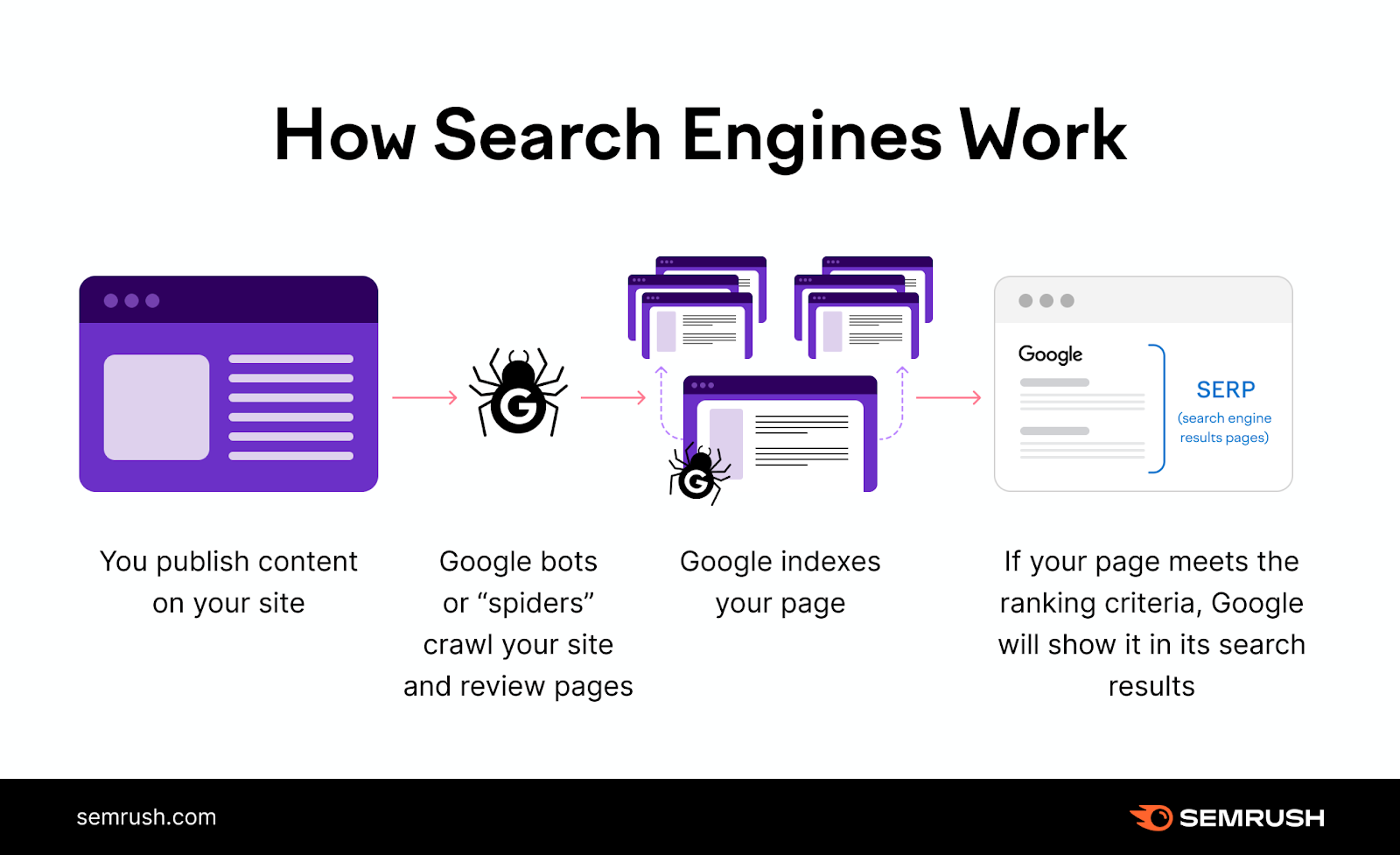SEO, known as Search Engine Optimization, is the optimization of business content and presence in the most popular search engines to gain organic traffic from them. You can grow your business organically and get more leads and profits. Nowadays, the internet plays a major role for both businesses and individuals, as an important aspect of establishing a successful online presence is Search Engine Optimization.

Disclaimer: This article on the page about SEO is written by Bilal Ahmad, an SE specialist with 3+ years of experience in search engine optimization and marketing. Further, if you have any concerns or need personalized guidance about SEO and rankings, you may visit the contact page.
SEO Functionalities
Search engine optimization (SEO) is a process that enhances a website’s technical setup, content relevance, and link popularity to improve its ranking on search engines. A website that ranks higher in Google gets more people to search for it, which means more people visit the website. SEO involves strategies desired to enhance a website’s visibility on popular search engines such as Google, Bing, and Yahoo.

Here are steps you can take to enhance your website’s SEO:
- Keyword Research: Identify relevant keywords for your brand, category, or industry and analyze their search frequency. This information can guide your content and marketing strategies.
- On-page SEO: Optimize webpages and content for both users and search engines. This includes optimizing title tags, URLs, and internal links and addressing search intent. For instance, organize keywords in page titles, URLs, meta descriptions, H1 text, and content. Optimizing titles can aid search engines and users in understanding your page’s topic, potentially boosting rankings and encouraging user clicks.
- Building Links: Develop a robust network of links directing to your website. You need to build high-quality follow-backlinks from high-authority domain-rating websites, which will help you build your site’s trust and improve your search results appearance.
- Monitor Results: Keep track of your website’s ranking in search engines. You can have good knowledge of Google Search Console and Analytics to analyze your site traffic and rankings. The more quality content you provide, the more trust you can build with your audience.
What is SEO?
Search Engine Optimization is the process of improving a website to rank more prominently in search engine results pages (SERPs). The primary goal of SEO is to increase organic (non-paid) traffic to a website by improving its visibility for relevant search queries. SEO involves various techniques, including keyword research, content creation, on-page optimization, and link building.

How Does SEO Works?
SEO works by making the user experience of a website more user-friendly for search engines. This is because search engines use algorithms to measure and rank websites based on hundreds of factors, such as relevance, authority, and user experience. By optimizing these factors, a website can achieve a higher ranking and attract more traffic.
Search Engine Optimization Analysis
Finding data or information about an obscure subject is typically searched on the first page of search engines. Users usually do not go through pages further than the first five result pages, making it absolutely essential to move a webpage to the top lists of search engines for a better impression. WordPress Website users must use SEO to achieve this, as it is possible to move a webpage to the first page of a search engine by following the necessary optimization rules.

An effective, well-structured, and visually appealing webpage is important for introducing a company, services, or products, but it is equally important for customers to find the webpage easily on a search engine. Moreover, 80 percent of Internet users search for products or services using search engines, mostly interactive advertisements (Internet 3, 2010).
A webpage is an easy and effective way to introduce and market a company. Information related to the company is obtained through search engines. In a competitive business environment, moving up the list can be achieved using search engine optimization.
Keyword Research
The keyword research is the building block of any successful SEO marketing effort and rankings. This process involves figuring out the terms and concepts that potential customers might engage in when searching for products or services related to your business. Keyword analysis tools like Google’s Keyword Planner, Ahrefs, and SEMrush can help you identify high-traffic keywords that are of interest to your niche.
Competitor Analysis
Looking into your competitors’ SEO practices can provide valuable insights into what works and what doesn’t. You can identify gaps in your own strategy and find opportunities to outperform them by examining their keywords, backlinks, and content.
Web Performance
Web performance is an exceptionally important factor in SEO. Search engines prioritize websites that load quickly and provide a seamless user experience. Website performance analysis tools like Google PageSpeed Insights and GTmetrix can help identify performance issues and suggest improvements.
On-Page Optimization
Meta Tags
Meta tags, including title tags, and meta descriptions, play a highly influential role in the search engine conversion process. The summaries provide a quick overview of a webpage’s content and help users figure out its relevance to a particular query.
Content Quality
High-quality, relevant content is essential for SEO because Search engines favor websites that provide valuable information to users. Focus on creating well-researched, engaging content that addresses the needs and interests of your target audience.
Internal Linking
Within-site linking, also known as internal linking, helps search engines find out the internal structure of your website and the connections between different pages. Moreover, it also improves user navigation and can increase the time visitors spend on your site.
Off-Page Optimization
Backlinks
Links from other sites, backlinks, or inbound links from other websites, are among the most valuable factors in SEO optimization. They signal to search engines that your website is authoritative and trustworthy. Focus on acquiring high-quality backlinks from reputable sources.
Social Media
Social media can amplify your SEO efforts by driving traffic to your website and increasing its visibility. Likewise, when you share your content on platforms like Facebook, Twitter, and LinkedIn, you can reach a broader audience and enhance your brand and business awareness.
Article Publishing
Regularly publishing high-quality articles can boost your SEO efforts. Blog posts, how-to guides, and industry news are all excellent types of content that can attract visitors and establish your website as an authority in your niche.
Search Engines and Directory Submission
Submitting your website to search engines and online directories can improve its visibility and increase its chances of being indexed. Use services like Google Search Console and Bing Webmaster Tools to submit your sitemap and monitor your site’s performance.
The Price of SEO Services
The cost of SEO can vary widely based on the size of your business, your niche scope, and your choice of SEO specialists. While some businesses invest between $1,500 and $5,000 per month in SEO, costs may range from as little as $100 per month to as high as $30,000. Likewise, you can hire an SEO expert by contacting us. We, at Yeilp: Your SEO Success Partner, offer premium SEO services at affordable, cost-effective price ranges.
Summarizing
Search Engine Optimization is a multifaceted discipline that requires a strategic approach to achieve success. By understanding what SEO is and how it works, and by implementing best practices for keyword research, competitor analysis, web performance, on-page and off-page optimization, and article publishing.
You can definitely improve your website’s visibility and attract more organic traffic. Furthermore, to stay in the SEO field, you must stay updated with the latest SEO trends and updates from Google, so you can improve your rankings and build your trust and authority.
How exactly does SEO work?
Search Engine Optimization (SEO) works by optimizing a website in a way that makes it more appealing to search engines. This involves various tactics, including keyword research, content optimization, and link building, to improve the website’s visibility and relevance to specific search queries.
What is an example of SEO?
An example of SEO would be a website that publishes high-quality content, uses relevant keywords effectively, and earns backlinks from authoritative websites. These practices can contribute to the website ranking higher in search engine results pages and attracting more organic traffic.
What is SEO and explain its process?
SEO, or Search Engine Optimization, is the strategy of improving a website to optimize the chances of ranking in search engine results pages. This involves various techniques, such as keyword research, on-page optimization, link building, and content creation, to increase the website’s visibility and attract organic traffic.
How do I use SEO step by step?
The implementation of SEO step by step involves conducting keyword research to identify relevant search terms and optimizing on-page aspects such as title tags, meta descriptions, and content. Establishing a network of high-quality backlinks from leading websites and tracking and analyzing the website’s performance using tools like Google Search Console and Google Analytics.
Discover more from Yeilp - (Start, Grow, and Scale Your Business)
Subscribe to get the latest posts sent to your email.






